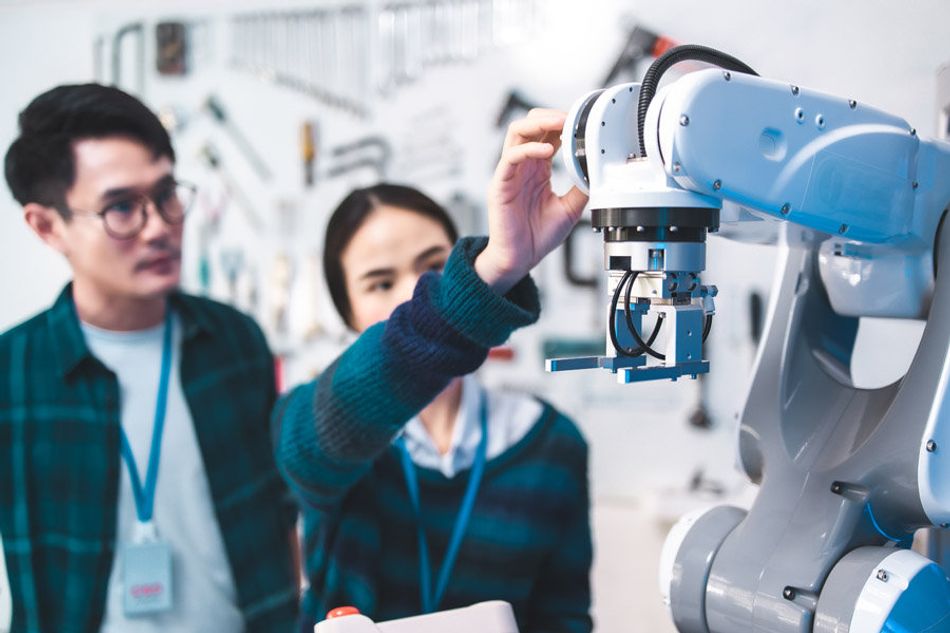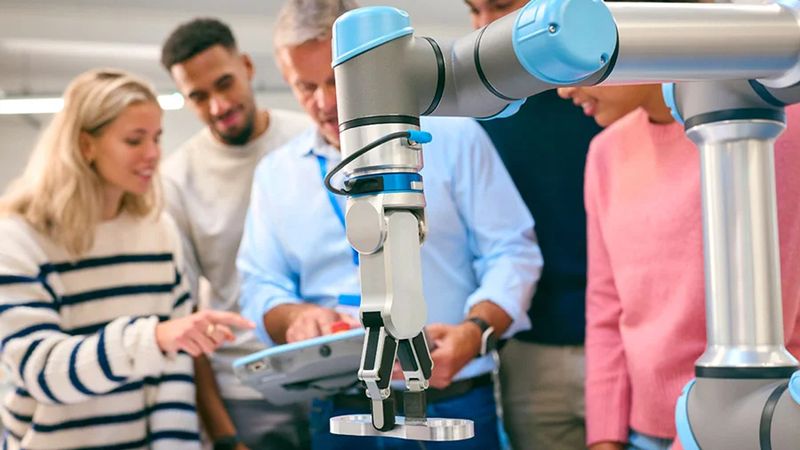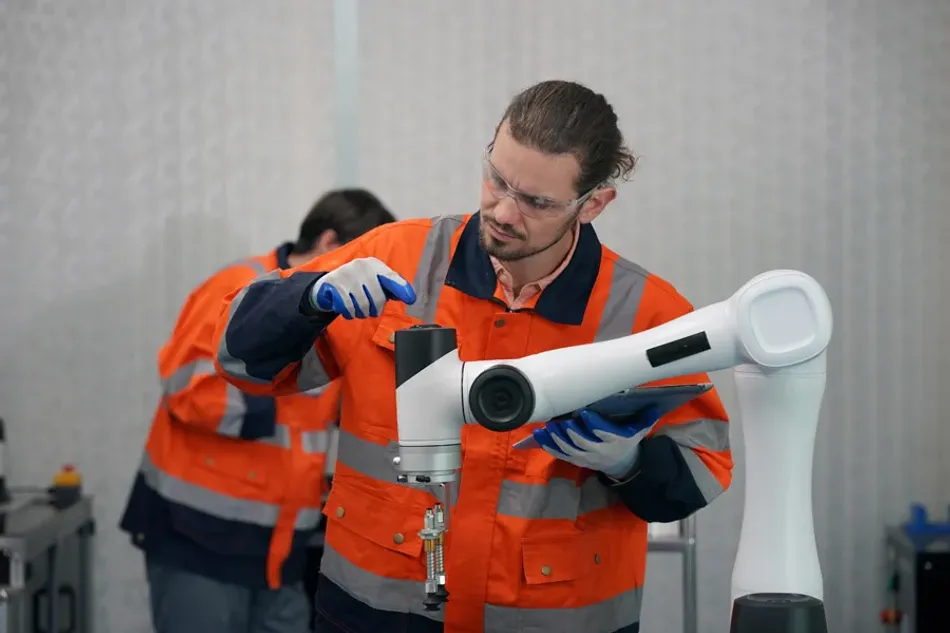What is a Cobot? The Ultimate Collaborative Robot Guide
In this guide, we'll comprehensively address these questions. We'll delve into what cobots are, their various types, how they compare to industrial robots, their benefits, and more to assist you in understanding whether they might represent the future of technology.
This article was first published on
www.botasys.comHow can we avoid repetitive tasks that slow down the production line? What innovative solution can accelerate production processes? A cobot might be the solution we're seeking. But what precisely is a cobot, and how can it benefit a business?
In this guide, we'll comprehensively address these questions. We'll delve into what cobots are, their various types, how they compare to industrial robots, their benefits, and more to assist you in understanding whether they might represent the future of technology.
Let's dive in!
What Is a Cobot?
As the name implies, a cobot, co-bot, or collaborative robot is designed to work hand-in-hand with humans within a shared space.
Unlike traditional robots that require separate operation areas, cobots are built with advanced sensors to safely collaborate with humans. They're also programmed to work at lower speeds and with decreased torque strength, enhancing their safety for use alongside humans.
These qualities mean they can assist workers with tasks ranging from simple material handling to complex assembly processes, boosting productivity while maintaining safety.
Types of Cobots
There's no one-size-fits-all cobot. There are different types of co-bots for different purposes. According to the International Organization for Standardization (ISO) 10218 standards, there are four types of collaborative robots. Here's an overview of each type:
Power and Force Limiting Cobots
These are perhaps the most popular and ubiquitous collaborative robots. They are designed with built-in sensors to detect human contact and apply force limits to prevent injury. This trait makes them ideal for direct interaction tasks, like assembly and light material handling.These cobots come with a variety of sensing technologies
Safety Monitored Stop Cobots
These sophisticated collaborative robots can stop operations immediately when they detect human presence within a specified area. The worker can reactivate the cobot's functions simply by pressing a button. This feature makes these cobots perfect for tasks that require minimal human intervention.
Speed and Separation Monitoring Cobots
These cobots use advanced vision systems to adjust their speed or stop based on the proximity of human workers. This characteristic makes them ideal for tasks that require controlled movement near humans, like welding.
Hand Guided Cobots
As the name suggests, hand-guided cobots allow workers to control their movements manually with a handheld device. This quality makes them perfect for meticulous tasks like product customization.
Collaborative Robots Vs. Industrial Robots: Key Differences
Collaborative robots share several similarities with industrial robots. However, the two robots aren't quite the same. Let's explore the key differences between the two robots to help you make an informed decision on which one to choose:
Purpose
Industrial robots are designed for independent, high-volume tasks, such as heavy material handling, welding, or large-scale painting. On the other hand, cobots work alongside humans, assisting with repetitive tasks like packaging, quality control, or material handling in collaborative workspaces.
Safety
Given their power and speed, industrial robots are often placed in cages or other confined areas to keep workers safe. Conversely, with their built-in safety features, cobots operate safely near humans, eliminating the need for cages.
Ease of Programming
Due to their complexity, industrial robots typically require engineers to set up and program. With their user-friendly interfaces and intuitive programming, cobots require minimal programming knowledge to set up.
Cost
With their high initial costs and infrastructure requirements, industrial robots are pretty costly. With their lower upfront costs and minimal infrastructure requirements, cobots are generally more affordable, making them an enticing option for small and medium-sized businesses.

Programming a Cobot
Programming industrial robots require in-depth knowledge of programming languages like C++, Python, or Java. However, industrial collaborative robots require little to no programming experience to set up. So, they're relatively simple to set up.
Most cobots have intuitive graphical interfaces (GUIs) or teach pendants. These tools allow workers to program the robot by simply moving its arm to the desired positions and recording these movements. It's like guiding a friend's hand — it's that straightforward.
However, for more complex or meticulous tasks, cobots also support more advanced programming via proprietary or open-source software platforms. These platforms often feature drag-and-drop builders for coding, making it easier for workers to define more complicated tasks or integrate the cobot with other machines on the production line.
This user-friendly nature of cobots makes them easy to deploy quickly. Additionally, it makes them ideal for small and medium-sized businesses that may not have the technical personnel for robotic programming.
Applications of Cobots
Collaborative robots have a variety of applications, particularly because of their exceptional versatility. Here are some common use cases of cobots:
Assembly
Cobots excel in assembly tasks, like screwing, gluing, and insertion, where precision and consistency are critical. They can work alongside human workers, assembling parts with incredible accuracy. A critical component for reliable assembly is the force torque sensing.
Packaging
Cobots are excellent at repetitive tasks like packaging, as they can pack goods faster and more efficiently than humans. Similarly, they're adept at palletizing, as they can stack products in predefined patterns, saving space and reducing labor costs.
Machine Tending
Cobots can operate machinery and load and unload parts, freeing up your human workforce for more complicated tasks.
Quality Inspection
Thanks to their sophisticated sensors and cameras, collaborative robots can conduct thorough inspections of products, ensuring they have no defects.
Material Handling
Cobots can safely transport materials and products from place to place, eliminating the need for human workers to lift and transport items manually.
Welding
Cobots can perform complex welding tasks like spot or arc welding with exceptional speed and precision.
Industries That Use Cobots
Cobots have been the unsung heroes in the manufacturing industry for years — working diligently alongside human workers to perform various tasks such as assembly, material handling, and machine tending.
However, besides the manufacturing industry, here are some other industries where collaborative robots play an integral role:
Automotive Industry
Automakers use cobots for various tasks, including assembly, painting, and quality control. Cobots can adapt to different vehicle models and configurations, making them perfect for dynamic automotive production lines.
Pharmaceutical Industry
Collaborative robots excel at performing tasks like packaging and quality control. This characteristic makes them suitable for the healthcare industry, where consistency is critical to prevent contamination.
Electronics Industry
Workers in the electronics industry often work with tiny components. Cobots are great at assembling, testing, and handling tiny parts, minimizing human error.
Food and Beverage Industry
In the food and beverage industry, collaborative robots are used in packaging, sorting, and handling, minimizing the risk of contamination.
Plastics Industry
In the plastics industry, where production typically involves creating a diverse range of products in small batches, automation has been challenging due to the dynamic nature of manufacturing processes.
Collaborative robots, with their adaptability, have provided a solution, making automation simple and efficient even in constantly evolving production environments.
Pros of Cobots
Collaborative robots offer a variety of benefits to businesses across multiple industries. Some of these benefits include:
Enhanced Productivity
Cobots are tireless workers. They handle mundane tasks with precision, allowing human workers to focus on higher-level tasks.
Flexibility
Cobots are renowned for their adaptability. They can easily switch between tasks with minimal downtime, making them perfect for dynamic production environments. Whether it's assembly, machine tending, or quality control, they can adjust swiftly to meet your changing needs.
Enhanced Safety
Collaborative robots have built-in safety features like sensors to minimize workplace accidents. Their presence means risky tasks like lifting heavy materials can be offloaded, enhancing overall safety and worker well-being.
Ease of Use
Programming a cobot doesn't require advanced coding skills. They often boast intuitive interfaces and drag-and-drop builders, making them accessible even for non-technical users. Ideal for SMEs that don’t have the financial capacity for a industrial robot installation.
Cost-Effective
Cobots cost less to purchase upfront and maintain than industrial robots, making them a cost-effective solution.
Enhanced Quality
Collaborative robots are nearly infallible, unlike humans. Their unwavering precision minimizes defects, improving overall product quality.
Cons of Cobots
While cobots offer numerous advantages, they aren't flawless. Here are some of their downsides:
Limited Payload Capacity and Speed
Collaborative robots are designed for light tasks and can't match the payload capacity or speed of traditional robots, making them unsuitable for heavy-duty tasks and high-volume production lines.
Slight Learning Curve
Although collaborative robots are easier to program than industrial ones, there's still a learning curve involved in integrating them seamlessly into your workflow. So, be prepared to invest time and resources to train your team.
Automate Your Operations With Cobots Today
Cobots can be a game-changer for a business, particularly for small or medium-sized enterprises that could benefit from automation.
By implementing cobots, you can boost productivity, enhance product quality, and increase production capacity, which could improve your bottom line.



